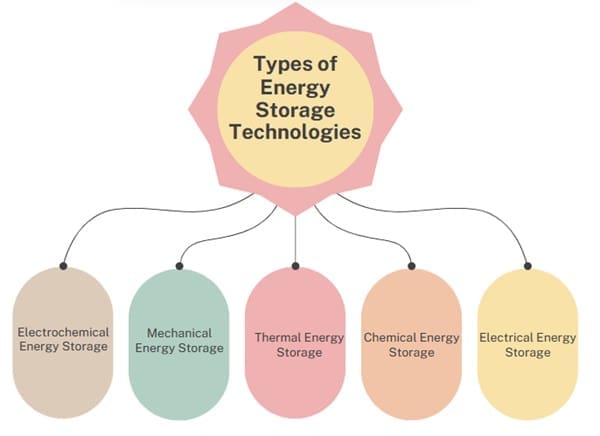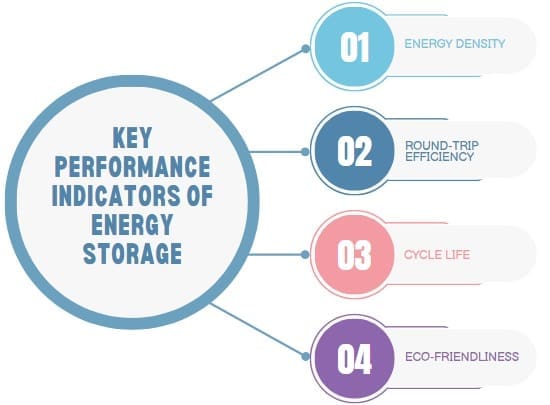An Energy Storage System (ESS) is a technology that captures energy for use at a later time. Energy storage systems are essential for balancing energy supply and demand, especially when dealing with intermittent energy sources such as solar and wind power.
The purpose of an ESS is to store excess energy generated when supply exceeds demand and release it when demand is higher than supply.
There are various types of energy storage systems, each with its own specific application, technology, and challenges. These systems are categorized into electrochemical, mechanical, thermal, and chemical types. Each type offers distinct advantages and limitations, depending on the storage duration, efficiency, and application needs.
Table of contents
What is an Energy Storage System?
An Energy Storage System (ESS) stores energy for later use. Stored energy can meet demand, balance energy supply, and improve system efficiency. These systems have become vital for balancing supply and demand, especially as renewable energy integration produces energy intermittently.
Energy storage devices can be classified into various categories based on the technology they use. The categories include mechanical, electrochemical, chemical, electrical, and thermal. These technologies play a crucial role in energy distribution systems, providing backup and load balancing.
Types of Energy Storage Technologies

We can broadly divide energy storage technologies into five categories: mechanical, electrochemical, chemical, electrical, and thermal. Let’s take a deeper look at each category:
Electrochemical Energy Storage
Electrochemical storage systems store electricity in batteries or supercapacitors. These systems use different materials for the anode, cathode, electrodes, and electrolytes. The system stores and releases energy through chemical reactions. Some of the most common electrochemical storage systems include:
- Lithium-ion Batteries: Currently, the most widely used type of energy storage due to their high energy density, efficiency, and relatively low cost. They are used across various scales, from utility to residential applications.
- Lead-Acid Batteries: An older technology with lower efficiency and energy density than lithium-ion but still widely used for certain applications.
- Supercapacitors: Known for their ability to release energy very quickly. They have a lower energy density than batteries but serve applications that require rapid charge and discharge cycles.
Electrochemical energy storage systems are particularly useful in grid services, demand shaving, and microgrid operations. However, they face challenges such as cost (especially at large scales) and thermal runaway risks (especially in lithium-ion batteries).
Mechanical Energy Storage
Mechanical energy storage systems directly store potential or kinetic energy. The most common forms of mechanical energy storage are:
- Pumped Storage Hydropower (PSH): Involves pumping water uphill to a reservoir during periods of low demand and releasing it to generate electricity when demand is high. PSH is the oldest form of large-scale energy storage.
- Compressed Air Energy Storage (CAES): Compresses air into underground caverns or large containers during low-demand periods. The compressed air is released and heated to generate power when needed.
- Flywheels: Store energy in the form of rotational kinetic energy. A flywheel stores energy by spinning a rotor at high speeds. Energy is released when the rotor slows down.
These systems generally serve large-scale applications, such as grid storage and grid services. They can offer long-duration storage (up to 24 hours) and are reliable for bulk grid storage. However, geographic requirements and large physical footprints limit them.
Thermal Energy Storage
Thermal energy storage systems store excess energy as heat or cold for later use. These systems use two primary methods to store thermal energy:
- Sensible Heat Storage: Involves storing energy by raising the temperature of a material. Molten salt is a popular material used for this purpose. It can store large amounts of thermal energy at high temperatures.
- Latent Heat Storage: Uses materials that undergo a phase change (from solid to liquid or vice versa) to store and release energy. In cryogenic storage, energy stores as extremely cold liquids like liquid air or nitrogen.
Thermal energy storage is typically used in utility-scale storage and grid services. It is particularly useful for long-duration storage (up to 24 hours). Challenges include high temperature operating requirements and the need for large-scale infrastructure.
Chemical Energy Storage
Chemical energy storage involves storing electrical energy by creating hydrogen through processes like water electrolysis. We can store hydrogen and use it in fuel cells to produce electricity when needed. We can also produce it from natural gas through steam-methane reforming, though this method releases emissions.
Hydrogen storage provides long-term and transportable storage, making it an ideal solution for seasonal storage needs. However, hydrogen storage faces challenges such as high costs and uncertainty around tax credits for the sector.
Electrical Energy Storage
Electrical energy storage involves storing energy in electromagnetic fields. A common example is the superconducting magnetic energy storage (SMES) system. This technology uses a superconducting coil to store electricity in a magnetic field.
SMES systems have fast response times and can deliver high bursts of power, making them ideal for grid support and power quality applications.
Key Performance Indicators of Energy Storage

When evaluating energy storage technologies, several key performance indicators (KPIs) are considered. These KPIs help determine which technology is most suitable for a specific application. Key performance factors include:
Energy Density: This refers to the amount of energy stored per unit volume or weight. Technologies like lithium-ion batteries offer higher energy density than traditional lead-acid batteries, making them more efficient for mobile applications like electric vehicles.
Round-trip Efficiency: The round-trip efficiency refers to the percentage of energy retrieved from storage compared to the energy required to store it. A higher round-trip efficiency means the storage process loses less energy. Lithium-ion batteries achieve a round-trip efficiency of about 95%, while lead-acid batteries range from 60% to 70%.
Cycle Life: This refers to how many charge and discharge cycles a battery or energy storage system can undergo before its performance significantly degrades. Lithium-ion batteries generally have a longer lifespan than lead-acid batteries.
Eco-friendliness: An important consideration for any energy storage system is how environmentally friendly it is. Technologies that use recyclable materials and produce fewer harmful byproducts are considered more eco-friendly.
Energy Storage Technologies by Duration
Energy storage systems vary in the duration they can store energy. Some technologies are suited for short-duration storage, while others are designed for long-duration storage.
- Short Duration (Seconds to minutes): Systems like supercapacitors and flywheels provide rapid energy release for brief bursts, often for grid support and backup power.
- Medium Duration (Minutes to hours): Lithium-ion batteries, flow batteries, and lead-acid batteries are typical in this category. These systems are useful for grid services, peak shaving, and microgrid operations.
- Long Duration (Days to months): Pumped storage hydropower and compressed air energy storage are examples of long-duration systems, typically used for bulk grid storage and grid capacity services.
Key Energy Storage Technologies

Lithium-ion Battery Energy Storage Systems (BESS)
Lithium-ion BESS is the most common and widely deployed technology. These systems are used in utility, commercial, and residential applications. Their typical duration is between 1-6 hours, making them suitable for grid services and demand shaving.
However, they face challenges, including cost and the risk of thermal runaway. There are also siting constraints related to the amount of space required for large-scale systems.
Vanadium Redox Flow Batteries
Vanadium flow batteries are particularly useful for commercial-scale applications. They typically last less than one hour and serve common applications such as uninterruptible power supply (UPS) and power quality support. However, these systems face challenges such as high capital costs and low energy density.
Supercapacitors
Supercapacitors are excellent for applications that require rapid discharge and fast charging. They are commonly used in commercial and utility-scale applications. Their typical duration is very short, often lasting just seconds to minutes.
While supercapacitors excel in power delivery, they have low energy density, which limits their use in long-duration storage. They are ideal for high-demand loads and situations where energy must be delivered quickly.
Hydrogen Storage
These storage systems primarily serve long-term energy storage and are especially useful for seasonal-scale storage. We produce hydrogen through water electrolysis or by using natural gas. These systems have challenges like cost, storage efficiency, and uncertainty around tax credits.
Hydrogen storage systems are gaining attention as they offer a promising solution for long-duration energy storage and long-term storage for transportable energy.
Pumped Storage Hydro (PSH)
Pumped storage hydro is the oldest and most established form of mechanical energy storage. It stores energy by pumping water into a higher reservoir during off-peak hours and releasing it to generate electricity when needed. PSH typically has a duration of up to 24 hours, making it a great option for bulk grid storage.
However, PSH systems require geological suitability for large-scale projects and have long development lead times.
Compressed Air Energy Storage (CAES)
Compressed air energy storage (CAES) involves compressing air into underground caverns or containers during periods of low energy demand. We release the compressed air to generate electricity when needed. CAES systems have a long duration of up to 24 hours and serve bulk grid storage.
Geological requirements and the large scale of the installations limit CAES systems.
Thermal Energy Storage Systems
Thermal energy storage is a promising solution for long-duration grid storage. Molten salt, for instance, can store heat during the day when solar energy is abundant and release it at night. These systems have a duration of up to 24 hours and are useful for grid capacity services and bulk grid storage.
Thermal energy storage faces challenges such as the need for large-scale infrastructure and the requirement for high-temperature operations.
Applications of Energy Storage Systems
Energy storage systems play a vital role in modern power grids. They help balance energy supply with demand, enhance grid reliability, and facilitate renewable energy integration. Some key applications of energy storage include:
- Backup Power and Uninterruptible Power Supply (UPS)
Energy storage systems provide backup power in case of grid outages. These systems are crucial for industries, hospitals, and data centers, where continuous power is critical. Batteries, particularly lead-acid and lithium-ion, are commonly used in UPS applications. - Grid Support and Stability
Energy storage systems help stabilize the grid by smoothing out fluctuations in power supply. These fluctuations are common when renewable energy sources like wind or solar power are involved. Energy storage systems can store excess power during times of low demand and release it during peak demand periods. - Frequency and Voltage Regulation
Maintaining stable frequency and voltage levels is essential for the reliability of the power grid. Energy storage systems like supercapacitors and flywheels provide rapid response times to address frequency and voltage irregularities. - Renewable Energy Integration
Energy storage enables better integration of renewable energy sources into the grid. Since renewable energy generation is intermittent, energy storage systems store excess power generated during peak production times and release it when renewable power is insufficient. - Peak Shaving and Load Shifting
Energy storage systems are used to shift energy use from peak times to off-peak times. This process, called peak shaving, helps reduce energy costs and prevents grid congestion during periods of high demand. - Grid Deferral and System Reinforcement
Energy storage systems can reduce the need for costly infrastructure investments by deferring the need for additional transmission and distribution lines. These systems can store power at strategic locations, reducing the need to upgrade the grid. - Power-to-Gas (P2G) Systems
Power-to-gas systems convert excess electricity into hydrogen or synthetic natural gas, which we can store and later use for power generation or heating.These systems are particularly useful in areas with a high penetration of renewable energy.
Future of Energy Storage Systems
The future of energy storage focuses on improving the efficiency, capacity, and cost-effectiveness of current technologies. Next-generation energy storage technologies, such as lithium-sulfur and lithium-air batteries, are expected to deliver higher energy densities and lower costs.
Additionally, advances in battery management systems (BMS) and thermal management systems (B-TMS) are improving the reliability and safety of energy storage systems. These technologies help prevent overheating and ensure that the system operates within its specified limits, further enhancing their performance.
The growing demand for electric vehicles, renewable energy, and reliable grid systems will continue to drive innovation in energy storage technologies. As these systems become more affordable and efficient, they will play a critical role in supporting the global transition to a sustainable energy future.
Final Words
Energy storage systems are critical for modern power grids and the integration of renewable energy. These systems provide backup power, enhance grid stability, and support renewable energy sources. With advancements in battery technology and growing demand for energy storage solutions, these systems will play an even more significant role in the future energy landscape.


















